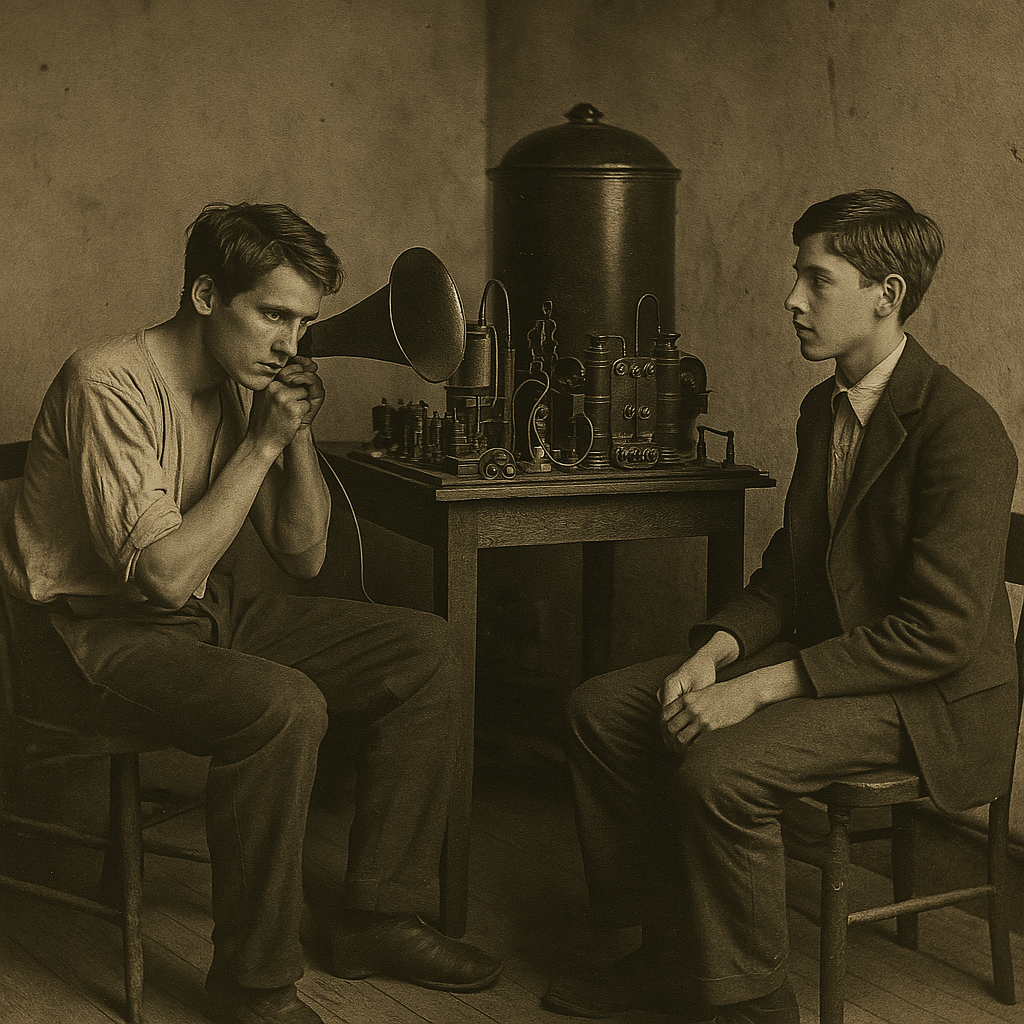(Construct Reference: AE-R/13 – “Dream Chamber”)
Status: Sealed, Power Disconnected (Unconfirmed)

This intricate black-and-white photograph reveals the only known image of the Morrow Receiver, a device theorised to decode and transcribe dreams into low-frequency acoustic signals. Comprising winding copper filaments, a tri-phasic aether dome, and a mirror-finish coil chamber, the device was housed within a lead-lined study beneath the East Archive.
Legend holds that the receiver could interpret REM field fluctuations within a subject’s vicinity — requiring no physical contact. Operators often reported waking with residual phrases or vivid recollections of others’ dreams, sometimes written in languages they had never studied.
Notably, a reflective surface on the front panel captured images not present in the room at the time, which led to the chamber’s closure in 1886 after an unrecorded “observation feedback loop” incident.
Believed to be a collaboration between Finch and Wren, the Morrow Receiver was designed to interpret human dreams through the skin via conductive copper membranes. Though never released, it was tested on four individuals, two of whom later spoke in perfect unison for thirteen minutes. No blueprints survive. A burned schematic was found in the East Cellar in 1982, folded inside a boot.
Purpose & Design
The Morrow Receiver was developed between 1881 and 1883 under the personal direction of Dr. Abram Finch and theoretical guidance from Octavius Wren, though only Finch’s name appears on the internal schematics.
Its stated purpose was deceptively simple:
To listen while others dream.
But it did not record dreams in the traditional sense. The Receiver was constructed to translate REM field disturbances — the energetic phenomena that flicker between memory and subconscious thought — into acoustic resonance patterns, which could be analysed and possibly played back.
Unlike other devices of its time, the Receiver required no contact with the sleeper. The chamber itself was tuned to react to emotional, not biological, presence. According to Finch’s notes, this required:
-
A mirror-lined core, to “contain the reflective pulse”
-
A dream induction coil made from “unstruck copper”
-
A harmonic key tuned at 107.3 Hz, which was described as “the tone of unvoiced intention”
Human Testing & The Subject
In June of 1883, the Receiver was tested on a StormCroft assistant referred to only as “Subject R.” Later identified through annotations as Randall Pierce, a 23-year-old linguistics apprentice from Tavistock.
Pierce’s qualifications:
-
Had suffered chronic lucid dreams
-
Spoke in his sleep in unknown phonemes
-
Had no known family or living ties
For three nights, Pierce was observed sleeping inside the Dream Chamber. The Morrow Receiver was powered only during REM cycles. On the fourth night, he failed to wake.
When the chamber was opened:
-
Pierce was still breathing but unresponsive
-
Copper sigils had burned faintly into the inner glass
A recorded low hum was traced to the mirror surface — it repeated a phrase in six languages:
“The dream is speaking now.”
Pierce never regained consciousness. He remained in a trance for 91 hours before vanishing entirely from his bed during a generator shutdown.
No signs of forced exit. Only a faint smell of citrus and a reversed heartbeat traced into the coil wire.
Shutdown & Attempted Destruction

This late 19th-century sepia-toned photograph captures Randall Pierce, the 23-year-old linguistics apprentice, alongside a younger unnamed assistant — Aide No. 4 — during a live calibration session with the experimental Morrow Receiver.
Taken inside Testing Room Delta, the image shows the pair aligning resonance dials along the left flank of the device. Pierce’s notes would later indicate the receiver was already generating low-vocal emissions despite being unpowered. The younger assistant, believed to be 16 at the time, later claimed to hear a voice calling his name in Pierce’s handwriting.
The room’s lighting was reportedly warmer than standard due to the excess ambient heat generated by the copper spine of the machine — giving the room a “drowsy, golden shimmer,” as later described in a technician’s log. The photograph was recovered in 1984 from a sealed envelope marked “Only If Reversed.”
The Morrow Receiver was sealed by order of Wren and classified as a “Temporal Interference Risk.” However, no consensus could be reached on how to safely dismantle the core.
Between 1884 and 1901, three attempts were made to destroy it:
-
Magnetic Pulse Overload (1886):
Resulted in all clocks within 200 feet reversing for two hours. -
Physical Disassembly Attempt (1890):
Led to a mirror fracture that exposed a reflected image of a room that did not exist. -
Controlled Burn Directive (1901):
Failed. The receiver casing turned cold and emitted Pierce’s recorded voice reading from a book he’d never owned.
Eventually, the chamber was sealed behind iron plating. Finch’s final note in the project file reads:
“Not destroyed. Merely forgotten forward.”
Present Status & Risk Assessment
-
Officially: Switched off
-
Unofficially: Still humming faintly, according to maintenance logs from 1957, 1966, and 1981
-
Security Classification: Level V – Echo Retention Hazard
-
Physical Access: Restricted under Echo-17
The room is not listed on modern StormCroft blueprints. A hallway leading to its vault is lined with unmarked portraits, none of which match employee records.
Future Considerations
The Morrow Receiver remains one of the few StormCroft devices that resisted interpretation. It neither reveals nor withholds. Instead, it appears to hold space for memory yet unspoken, or perhaps not yet imagined.
Some theorists speculate that Pierce was not a victim, but a conductor — and that the Receiver never malfunctioned. It simply opened a door no one remembered closing.
Rumours suggest that during major solar storms, the walls near the vault vibrate at 107.3 Hz — and occasionally, employees report dreaming together, without knowing each other’s names.
